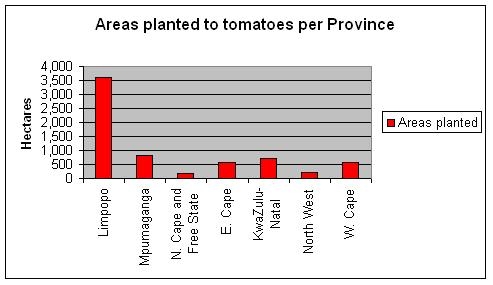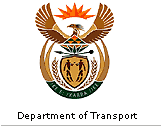 |
Fruit and Vegetable ProductionAgriculture as a sector together with its downstream
activities,
contributes 15-16% of the Gross Geographic Product of
KwaZulu-Natal. Due to the good reliable rainfall and
fertile soils, the region's agricultural sector has become
very productive, and is known for its specialist
capability in several types of farming. The province has
a total of 6.5 million hectares of land for farming
purposes of which 82% is suitable for extensive livestock
production and 18% is arable land. Deciduous fruitThe production of deciduous fruit in South Africa during
2005/06 is
estimated at 1,415,121 tons, which is 6 % lower than in
2004/05. Most of the deciduous fruit is produced in the
Western and Eastern Cape.
Although some producers grow fruit both for canning and
fresh consumption, it is estimated that in South Africa
there are about 2,455 producers of fruit for fresh
consumption, 1,100 producers for canned fruit and 1, 105
producers for dried fruit.
Subtropical fruitIn terms of the value of production, the subtropical fruit
industry earned R1, 497 million in 2005/06—an
increase of
3,9 % on the 2004/05 figure of R1,441 million. The
cultivation of some types of subtropical fruit is only
possible in certain specific areas of the country because
of particular climatic requirements. In general,
subtropical fruit types require warmer conditions and are
sensitive to large temperature fluctuations and to frost.
Therefore, fruit types such as granadillas and guavas are
grown in the Western Cape, while pineapples are cultivated
in the Eastern Cape and KwaZulu-Natal. The total South
African production areas of avocados, bananas, mangoes,
litchis and pineapples during 2005/06 are estimated at
approximately 12,000, 11,568, 7,748, 3,000 and 13,581 ha,
respectively. The total production of subtropical fruit
increased by 1,5 %, from 709,815 tons in 2004/05 to 720,
648 tons in 2005/06.
The production of bananas and litchis increased by 15,8
and 4,2%, respectively. However, the production of
mangoes, granadillas, papayas and avocados decreased by
31,6, 26,7, 14,2 and 9,1%, respectively. The warm winter
climate, drought conditions in certain production areas
and the previous season’s good crop had a negative
impact on the total mango crop. Bananas,
pineapples and avocados contributed 50,9, 23,2 and 10,4 %,
respectively, to the total South African production of
subtropical fruit during 2005/06. The humid low-lying
coastal belt in north-eastern KwaZulu-Natal as well as the
South Coast (Port Edward to Port Shepstone), are the best
suited to banana production.
From 2004/05 to 2005/06, total exports of subtropical
fruit in South Africa decreased by 13,2 % to 55,479 tons,
and the average export price for all subtropical fruit
decreased by 7,3%. Citrus fruitCitrus fruit is grown in the Limpopo, Mpumalanga, KwaZulu-
Natal, Eastern Cape and Western Cape. The area under citrus
for 2005 is
estimated at 57,168 ha. Oranges constitute about 63 % of
the total production of citrus fruit in South Africa. In
2004/5, 4,139 hectares were planted for citrus cultivation
in KwaZulu-Natal. A total of 1,9 million tons of citrus
were produced in South Africa in 2004/05, which was a 5%
decrease compared with 2003/04, of which KwaZulu-Natal
produced approximately 187,000 tons. The suitable areas
for navel oranges are Muden, Richmond and
Nkwaleni, and for valencias Pongola and Mkhuse. VegetablesVegetables are grown all over the country. In 2005, 730
hectares of KZN land were under tomato cultivation and
produced 36,500 tons of tomatoes. Total production figures
for KwaZulu-Natal were estimated at 36,500.

|
Other products also grown in the province are potatoes,
which are found in the high-lying areas, cauliflower,
cabbage (Camperdown and Greytown districts), carrots, etc.
The climate of most of KZN is not really suitable for
large-scale commercial production of onions. Production
for own use, or for limited local sales, however, is viable.
In 2002, the province produced 85,000 tons of potatoes,
2,188 tons of cauliflower and 44,600 tons of cabbage. These
products are not grown on a large scale when
compared with provinces such as Limpopo and
the Western Cape. Most of the potatoes grown in
2002 according to SA Stats were from Mooi River,
Underberg and Mount Currie. During 2005/06, approximately
89 million x 10-kg pockets of potatoes were sold on the
major fresh produce markets, as against 91 million in
2004/05. During 2005, approximately 20 % of the total
production of potatoes was taken in for processing. About
58 % of these potatoes were processed into chips,
both fresh and frozen, while 40 % was used for crisps. The
remaining 2 % was used for canning, mixed vegetables, and
others. The processing of potatoes showed an upward trend
of 1,9 % between 2003 and 2005.
The areas of cabbage production was scattered all across
the province with the largest concentrations centred
around Camperdown, Ixopo, Alfred and Richmond areas. TransportTransport from farms to packing and processing plants, or
directly to the fresh produce market, is all done by road.
Once cleaned, graded, washed and packed, the products are
transported to markets using a variety of truck
configurations ranging from rigids and drawbar-trailers to
interlinks, depending on distance, nature of the product
and whether cooling is needed. Vegetables are mainly
consigned to the main metropolitan markets or wholesale
dealers.
The Johannesburg fresh produce market remains the biggest
outlet for distribution, followed by the Tshwane, Cape
Town and Durban markets.
|
 |



